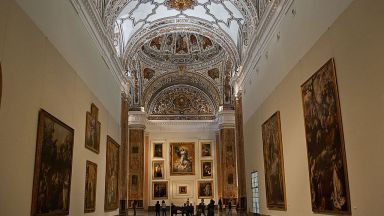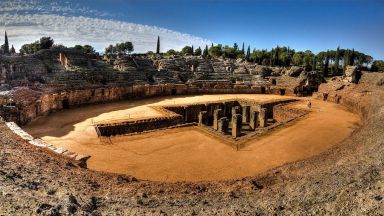Royal Shipyards of Seville
Historic Building and Shipyard in Seville
The Royal Shipyards of Seville are a medieval shipyard operative between the 13th and 15th centuries, in the city of Seville, Spain. The shipyards specialized in the construction of galleys and played an important role in the struggles for the control of the Strait of Gibraltar. They also helped the Castilian participation in the ‘Hundred Years’ War. The shipyards of Seville consisted of a large building with seventeen naves, which were near to a large sandy area of the Guadalquivir River.
History of the Royal Shipyards of Seville
In 1248, Ferdinand III of Castile took Seville from the Moors, who had held the city since 712. This together with the fall of Córdoba, marked the retreat of the Moors from their strongholds on the Iberian Peninsula. In order to prevent possible future threats from northern Africa, Ferdinand III wanted to peruse his foe into northern Africa. In order to embark on a military campaign in northern Africahe would need a fleet of ships to transport and supply his army.
With Ferdinand’s death in 1252, his son, Alfonso X ‘The Wise’, wished to pushed ahead with his father’s plan. He decided to build the ‘Reales Atarazanas de Sevilla’, or the ‘Royal Shipyards of Seville’ for the construction of galleys on land outside the walls of the city and close to the river, in the area between the Torre del Oro (Tower of Gold), the Torre de la Plata (Tower of Silver), and the Postigo del Carbón’ or ‘Gates of Coal’ and the ‘Postigo del Aceite’ or ‘Gate of Oil’.
The shipyard covered about 15,000 square meters and consisted of 17 vaulted naves constructed entirely of brick, in a style now known as Mudejar-Gothic, with vaulted ceilings and wide arches connecting the naves. Construction was similar to those found in a church or cathedral. Each nave needed to be large enough for the construction of a galley, with each section of the shipyard connected to the next via a series of arches.
Before the end of 1253 ten galleys had been built in the shipyard, and it continued to produce fleets for subsequent Castilian kings. Galleys built in the Royal Shipyards of Seville were used throughout much of the remainder of the Reconquista, as well as during the Hundred Years’ War against England. During this time the naves were also used to hold prisoners and booty taken during the various conflicts.
Surprisingly, it was just after the discovery of the Americas in 1492 that the shipyards went into decline. This was probably because the naves were too small for building larger, more modern ships, and the incorporation of Aragon into a united Spain had made cheaper shipyards in Barcelona and Valencia available for the building of the navy’s ships. As orders for new ships began to dwindle the naves began to be used for purposes. In 1493, a fish market was moved into the first nave.
In 1641 five of the naves were converted for use as the Hospital de la Caridad, and in 1719 the seven naves we can still see became officially the headquarters of La Maestranza de Artillería, and were used for the manufacture, storage of artillery and for offices of the administration of the army until as late as 1970.
During the 16th century, other naves were reassigned as oil and wool warehouses, and three more to house the city’s customs warehouse.
The next big change to the structure of the shipyard came in 1945, when five naves were destroyed to make way for the construction of the Delegación de Hacienda (Tax Office) building. Fortunately, no further destruction took place before the shipyard gained National Monument status in 1969, protecting it from further damage.
The shipyard, however, has been an ongoing thorn in the side of the local government. For more than 20 years it has been off-limits to the public, despite various plans and proposals for its renovation, all of which have so far failed, generating more frustration.
The façade that can still be seen today was built in 1782, and the chimney, now used only by nesting storks, also belongs to this period. Finally, in 1945, the five naves at the Torre del Plata end of the complex were totally demolished to make way for new government offices.
But in December 2018, it was confirmed that restoration would begin in 2019, with the aim of opening the Royal Shipyards of Seville to the public in 2022.
Royal Shipyards of Seville and Game of Thrones
Many Game of Thrones filming locations have become major tourist draws thanks to the popularity of the HBO series. Fans will recognize the he shipyard was used to represent the crypts beneath the Red Keep in King’s Landing. In episode two of season 7 (“Stormborn”), Qyburn takes Cersei to the cellars where they shoot a bolt through the skull of the dragon Balerion. Later, in episode five (“Eastwatch”), Bronn leads Jaime to the cellars for a tense meeting with Tyrion.
History of Ship Building in Seville
The area has a history of ship building:
- It was first mentioned of it in the 1st century BC, when the civil war between Pompey and Julius Caesar. Julius Caesar ordered ‘Cádizans‘ to build ten ships of line in 49 B.C.
- In the 9th century a fleet of Vikings attacked Seville, this prompted ‘Caliph Abd ar-Rahman II ‘ to reinforce the wall of Isbylia (Seville) and to create a permanent war fleet and ordered the construction of a shipyard in Seville.
- In 1184, the caliph Abu Yusuf Yaqub al-Mansur ordered the then governor of the city, Abu Dawud Yalul ben Yildasan to build a large fleet to deal with the Christian kingdoms.
The Royal Shipyards of Seville appears in our Complete Guide to Visiting Seville!
Other names of Royal Shipyards of Seville
The Royal Shipyards of Seville has the following names: Seville Shipyard, Reales Atarazanas de Sevilla, Royal Shipyards of Seville.
This website uses affiliate links which may earn a commission at no additional cost to you!
Visiting Royal Shipyards of Seville
Closed until 2022.
N/A
Nearby Attractions
- Torre de la Plata (0.2) km
Tower in Seville - Tomb of Christopher Columbus (0.2) km
Cathedral and Tomb in Seville - Seville Cathedral (0.2) km
Cathedral, Historic Building and Mosque in Seville - Torre del Oro (0.3) km
Museum and Tower in Seville - El Giralda (0.3) km
Tower in Seville - Archivo General de Indias (0.3) km
Historic Building and Museum in Seville - Plaza de Toros de Sevilla (0.3) km
Historic Building and Museum in Seville - Barrio Santa Cruz (0.5) km
Area in Seville - Hospital de los Venerables Sacerdotes (0.5) km
Gallery, Historic Building and Museum in Seville - Casa de los Pinelo (0.5) km
Palace in Seville



